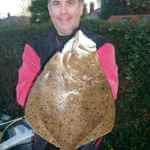 We have several species of flatfish in the UK and most behave in a similar way so we will deal with them in one section. The flatfish of interest to the UK spearfishermen are:
We have several species of flatfish in the UK and most behave in a similar way so we will deal with them in one section. The flatfish of interest to the UK spearfishermen are:
- Flounder
- Turbot
- Brill
- Plaice
- Sole
- Skates and Rays
Flounder flatfish
When to catch flounder:
All year round.
Where to catch flounder:
In shallow water where there is a muddy or sandy seabed. often found where freshwater flows into the sea from a beach.
Behaviour and hunting:
Flounders are by far our most numerous flatfish and are certainly the one most often caught by spearfishermen. To find flounders swim in shallow water 1-4m deep. Where the water is clear enough, look for them buried or resting in the sand or mud. When the water is murky, dive to midwater and swim parralel to the seabed about 2m above the bottom, looking carefully for the hidden flounders. They like to lie near seaweed covered rocks. When buried, look for the eyes and mouth sticking out of the sand. They have good camoflage and can be a variety of colours. When shooting them, always collect the fish rather than trying to pull up the spear; as they are lying on the sand or mud, the spear will often not toggle so you need to push them up the spear to be sure of your catch.
Eating:
7/10 – Flounder are tasty and can be cooked in a variety of ways. They are best left in the fridge for a couple of days as this improves the flavour and texture.
Weapon of choice:
Rob Allen Caranx 80 railgun
Turbot
When to catch turbot:
April to August
Where to catch turbot:
In deeper water- off Chesil and Abbotsbury beaches, and most famously on the shambles bank. 3m-30m
Behaviour and hunting:
Turbot are a very unusual catch. They are not often found, and will tend to be sat on a bank or in a depression. You will spend many hours looking for these fish, but if you are lucky enough to find one they are a real prize, growing to in excess of 30lbs. Turbot are best looked for on the shambles bank, on the shoulders between 18m and 25m, drifiting with the tide.
Eating:
10/10 – Turbot are one of the best fish we have for eating!
Weapon of choice:
Rob Allen Tuna or Zulu 100 with double 16mm rubbers- these are BIG fish!
Brill
When to catch Brill:
April to September.
Where to catch Brill:
As for flounders, but much more uncommon.
Behaviour and hunting:
Brill are a very unusual catch. They are not often found, but will usually be encountered when looking for flounders.
Eating
10/10 – Brill are superb eating!
Weapon of Choice:
Rob Allen Caranx 80
Plaice
When to catch plaice:
All year round
Where to catch plaice:
Two main places – firstly they like the same conditions as flounder. Secondly the bigger specimens are often found on the mussle beds off Portland in deeper water, 14-30m.
Behaviour and hunting:
Everything said about flounder applies to plaice. In addition you will find them sitting in the open on the mussle beds. This tends to be very deep diving and requires a lot of experience and effort. Some divers use variable ballast techniques to hunt big plaice in 30-32m, but this carries inherent risks and should not be attempted by anyone without specialist freediving training.
Eating plaice:
9/10 Plaice are great baked whole or filetted and cooked in a pan.
Weapon of choice:
Rob Allen Sutu or Caranx 80
Sole
When to hunt sole:
May to September
Where to hunt Sole:
Usually found on the beaches further east than Portland. Ringstead is a good place to find them. They are found in shallow water, close to shore.
Behaviour and hunting:
Exactly as for flounder
Eating:
10/10 – sole are one of the best and much prized for their flavour.
Weapon of choice:
70 Shanti or Sparid Railgun.
Skates and Rays
When to catch skates and rays:
All year round
Where to catch skates and rays:
All sandy or muddy areas. Portland harbour is very good for them.
Behaviour and hunting:
Much the same as for flounders but usually found in water deeper than 6m. They can be heavy fish to pull up from the seabed, so caution is needed with large specimens so it is sensible to either use a reel or have your gun connected to your floatline. The other difference with these flatfish is that they will bite you. Skates and Rays have powerful jaws so be very careful not to get bitten.
Eating:
6/10 – A matter of taste, some really enjoy skate, some do not. Well worth eating- cooked skate wings in a soy and chilli sauce is an excellent way to eat it. Like flounder, best left a couple of days in the fridge which improves texture and taste.
Weapon of choice:
80 Caranx or Sutu railgun
